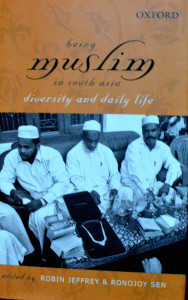 Going by the prominent western narrative, the Muslim world can be fitted into two categories, the good Muslims and the bad Muslims. This classification was one of the contributions of another western initiative, the ‘war on terror’ which began after September 11 attack on World Trade Center in the US. Soon, the model was copied across the world to identify bad elements among the community and devising policies to tackle the threat of ‘Islamic terror’. South Asia was the major theatre of this campaign as Afghanistan was identified as epicenter of the terror network.
Going by the prominent western narrative, the Muslim world can be fitted into two categories, the good Muslims and the bad Muslims. This classification was one of the contributions of another western initiative, the ‘war on terror’ which began after September 11 attack on World Trade Center in the US. Soon, the model was copied across the world to identify bad elements among the community and devising policies to tackle the threat of ‘Islamic terror’. South Asia was the major theatre of this campaign as Afghanistan was identified as epicenter of the terror network.
After 15 years of relentless and blood-socked campaign, the monster has grown bigger and the 500 million- strong community in this part of the world has been wrongly associated with terror. The narrative puts undue focus on terror and negates the myriad activities in which the community is involved like any other community in Asia.
Edited by Robin Jeffrey & Ronojoy Sen, Being Muslim in South Asia: Diversity and daily life is an attempt to question the western narrative and celebrate the diversities of Muslims in South Asia. In their introduction, the editors rightly observe that “The religion of Islam often captured the attention of the English speaking world after the devastation of 11 September 2001, but it was usually with a relentless focus on terror and conflict. Such preoccupation, eclipsing interest in the daily lives of South Asia’s Muslims, was mistaken and misleading”.
Of the 16 essays, six are about Indian Muslims dealing with diverse reactions of the community to the challenges of modernity and western imperialism since the pre-independence period. The community challenged the British colonialism with different orientation under various leaders such as Moulana Abul Kalam Azad, Muhammad Ali Jinnah, Maulana Husain Ahmad Madani and Maulana Mauduidi. Reaction to the present day challenges are also varied from individuals, orgainisations and community leaders.
While explaining the changing trends among Indian Muslims Barbara D Metcalf writes “…there is an effort now to stress shared economic needs more than the distinctive Muslim cultural concerns that have long been the hallmark of Muslim politics. The Muslim leadership in India also has to face the influence of Hindu right wing groups and rise of the oppressed bahujan. According to Metcalf it is these trends and concerns that are far more characteristic of Muslim behavior in India than any suspected militancy.
Primarily based on his research among Muslims in Delhi, Tanweer Fazal argues that the community faces constant stigmatization and discrimination on a day to day basis and it influences creating their identity. Again, the community reacts in varied forms and none of the respondents condone violence as a form of reaction to the challenges faced by the community.
In a scathing critique of the Indian media and the state, in his essay ‘Kafka in India’, Irfan Ahmad explains how media gloss over the alternative views and facts to create stereotyped and distorted images of Muslim community. “It is the dominant myth of nation, reiterated ceaselessly by the media, which defines terrorism and renders law peripheral, if not irrelevant,” he says.
While describing the fate of many terror cases in recent years he aptly borrows the simile from Kaftka’s Europe saying, “the sovereign decides before legal procedures unfold; judgment is delivered prior to trial”. It is my contention that mainstream media, certainly since 9/11, has often vilified Islam as an intolerant religion and Muslims as a threatening disloyal other. Mainstream media discourses on terrorism are intimately tied to the myth and narrative of the India nation state and its constitutive ‘other’, namely Muslims, he writes.
Explaining the role of Darul Uloom Deoband, one of the largest Islamic educational institutions in India, in shaping Muslim education and thinking Taberez Ahmed Neyazi admits the orthodox character of Deoband and exposes its narrow mindedness in dealing with many social issues. However, he argues, many of its progressive approaches in dealing with the other religious communities are neglected while controversial fatwas were played up by the media. He cites the example of an appeal to Muslim community by the Deoband scholars to avoid slaughtering cows respecting the sentiments of Hindu community.
Essays on Muslim life in Pakistan, Sri Lanka and Bangladesh also give insight to the diversity of the community in their respective countries and their constant struggle to adjust to the challenges to the changing world.